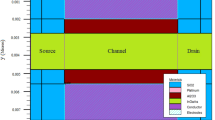Abstract
The quasi-static capacitance–voltage (QSCV) characteristics of 10-nm-gate-length double-gate N-type metal–oxide–semiconductor field-effect transistors (NMOSFETs) with Si, Ge, InAs, \( {\hbox{In}}_{0.53} {\hbox{Ga}}_{0.47} {\hbox{As}} \), and GaAs as channel materials are studied and simulated using Silvaco ATLAS three-dimensional (3D) technology computer-aided design (TCAD) software. The QSCV approach offers the advantage of immunity against frequency dependence effects and the ability to measure small capacitances in the 100 fF range. In this device, we consider the self-consistent solution of Schrodinger’s equation with Poisson’s equation. The splitting of the conduction band into multiple subbands is considered, while there is no doping in the channel region. The effects of metal gate electrode engineering, channel engineering (Si, Ge, GaAs, \( {\hbox{In}}_{0.53} {\hbox{Ga}}_{0.47} {\hbox{As}} \), and InAs), and different channel thicknesses with \( \left( {{\hbox{Al}}_{2} {\hbox{O}}_{3} } \right) \) as gate oxide having thickness of 0.8 nm on the QSCV characteristics are studied. A comparison of the QSCV characteristics is carried out for the above-mentioned channel materials, revealing a significant reduction in the inversion-mode QSCV characteristics for all the materials due to quantization that results in a decrease in the overall gate-to-channel capacitance and hence increases the threshold voltage of the MOS device. The QSCV characteristics are also useful to measure the oxide thickness, flat-band voltage, threshold voltage, maximum depletion region thickness, charge distribution in the dielectric, interface trap charge, and interface states between the channel and gate oxide before device fabrication.
Similar content being viewed by others
References
J. Tao, C.Z. Zhao, C. Zhao, P. Taechakumput, M. Werner, S. Taylor, and P.R. Chalker, Materials 5, 1005–1032 (2012).
G.E. Moore, Electronics 38, 114–117 (1965).
J. Robertson and R.M. Wallace, Mater. Sci. Eng. 88, 1–41 (2015).
R.S. Muller, T.I. Kamins, and M. Chan, Device Electronics for Integrated circuits, 3rd ed. (New York: Wiley, 2009).
H. Riel, L.-E. Wernersson, M. Hong, and J.A. del Alamo, Mater. Sci. Soc. 39, 668–677 (2014).
L. Chang, K.J. Yang, Y.-C. Yeo, I. Polishchu, T.-J. King, and H. Chenming, IEEE Trans. Electron Devices 49, 2228–2295 (2002).
J.C. Ranuárez, M.J. Deen, and C.-H. Chen, Microelectron. Reliab. 46, 1939–1956 (2006).
H. Wong and H. Iwai, Microelectron. Eng. 83, 1867–1904 (2006).
I. Krylov, D. Ritter, and M. Eizeberg, J. Appl. Phys. 122, 034505–034509 (2017).
X. Kong, R. Liang, X. Zhou, S. Li, M. Wang, H. Liu, J. Wang, W. Wang, and J. Pan, IEEE Trans. Electron Devices 63, 3084–3087 (2016).
S. Tewari, A. Biswas, and A. Mallik, IEEE Electron Device Lett. 33, 372–374 (2012).
Z. Jiang, B. Behin-Aein, Z. Krivokapic, M. Povolotskyi, and G. Klimeck, IEEE Trans. Electron Devices 62, 525–531 (2015).
P.S. Goley and M.K. Hudait, Materials 7, 2301–2339 (2014).
J. Robertson and B. Falabretti, J. Appl. Phys. 100, 014111 (2006).
M. Moreau, D. Munteanu, and J.L. Autran, Microelectron. Eng. 88, 366–369 (2011).
S. Rewari, V. Nath, S. Haldar, S.S. Deswal, and R.S. Gupta, Microsyst. Technol. 25, 1–10 (2017).
G.D. Wilk, R.M. Wallace, and J.M. Anthony, J. Appl. Phys. 89, 5243–5275 (2001).
M. Stucchi, D. Velenis, and G. Katti, IEEE Trans. Instrum. Meas. 61, 1979–1980 (2012).
A. Gocalinskaa, S. Rubinib, and E. Pelucchia, Appl. Surf. Sci. 383, 19–27 (2016).
F.L. Lie, W. Rachmady, and A.J. Muscat, Microelectron. Eng. 86, 122–127 (2009).
F.L. Lie, W. Rachmady, and A.J. Muscat, Microelectron. Eng. 87, 1656–1660 (2010).
M. Rebauda, M.C. Rourea, V. Loupa, P. Rodrigueza, E. Martineza, and P. Besson, ECS Trans. 69, 243–250 (2015).
S. Klejna and S.D. Elliott, J. Phys. Chem. 116, 643–654 (2012).
J. Alex and T. Gougousia, J. Vac. Sci. Technol. A 34, 031101–031109 (2016).
J. Lin, X. Zhao, D.A. Antoniadis, and J.A. del Alamo, IEEE Electron Device Lett. 35, 440–442 (2014).
M. Yokoyama, S. Kim, R. Zhang, N. Taoka, Y. Urabe, T. Maeda, H. Takagi, T. Yasuda, H. Yamada, O. Ichikawa, N. Fukuhara, M. Hata, M. Sugiyama, Y. Nakano, M. Takenaka, and S. Takagi, Appl. Phys. Express 5, 076501 (2012).
Silvaco ATLAS TCAD Version: ATLAS 5.19.20.R, 2020.
Y.H. Chang, C.A. Lin, Y.T. Liu, T.H. Chiang, H.Y. Lin, M.L. Huang, T.D. Lin, T.W. Pi, J. Kwo, and M. Hong, Appl. Phys. Lett. 101, 172104–172105 (2012).
T.W. Pi, Y.H. Lin, Y.T. Fanchiang, T.H. Chiang, C.H. Wei, Y.C. Lin, G.K. Wertheim, J. Kwo, and M. Hong, Nanotechnology 26, 164001 (2015).
T.W. Chang, K.Y. Lin, Y.H. Lim, L.B. Young, J. Kwo, and M. Hong, Microelectron. Eng. 178, 199–203 (2017).
L. Pirro, Electrical characterization and modeling of advanced SOI substrates, Ph.D. Thesis, Micro and nanotechnologies/Microelectronics. Université Grenoble Alpes, pp. 91, 2015.
L. Pirro, I. Ionica, G. Ghibaudo, X. Mescot, L. Faraone, and S. Cristoloveanu, J. Appl. Phys. 119, 175702–175710 (2016).
D. Lin, G. Brammertz, S. Sioncke, C. Fleischmann, A. Delabie, K. Martens, H. Bender, T. Conard, W.H. Tseng, J.C. Lin, W.E. Wang, K. Temst, A. Vatomme, J. Mitard, M. Caymax, M. Meuris, M. Heyns, and T. Hoffmann, Enabling the high-performance InGaAs/Ge CMOS: a common gate stack solution (Baltimore: IEEE International Electron Devices Meeting (IEDM), 2010).
R. Omar, B.A. Mohamed, and M. Adel, Eur. Phys. J. Plus 130, 1–13 (2015).
J. Schmitz, F.N. Cubaynes, R.J. Havens, R. de Kort, A.J. Scholten, and L.F. Tiemeijer, IEEE Electron Device Lett. 24, 37–39 (2003).
A. Alam, S. Ahmed, M. K. Alam and Quazi D. M. Khosru, C-V Characteristics of n-channel Double Gate MOS Structures Incorporating the Effect of Interface States, in 5th International Conference on Electrical and Computer Engineering (ICECE) 2008, 20-22 December 2008, Dhaka, Bangladesh.
S. Sato, K. Kobayashi, Y. Mori, D. Hisamoto, and A. Shima, Jpn. J. Appl. Phys. 59, 4 (2020).
B. Razavi, Design of Analog CMOS Integrated Circuits (New York: Tata McGraw-Hill, 2002).
Author information
Authors and Affiliations
Corresponding author
Ethics declarations
Conflict of interest
The authors declare that they have no conflicts of interest.
Additional information
Publisher’s Note
Springer Nature remains neutral with regard to jurisdictional claims in published maps and institutional affiliations.
Rights and permissions
About this article
Cite this article
Sanjay, Prasad, B. & Vohra, A. Effect of Channel Engineering on Quasi-Static Capacitance-Voltage Characteristics of Double-Gate MOSFET. J. Electron. Mater. 49, 5816–5823 (2020). https://doi.org/10.1007/s11664-020-08307-3
Received:
Accepted:
Published:
Issue Date:
DOI: https://doi.org/10.1007/s11664-020-08307-3




